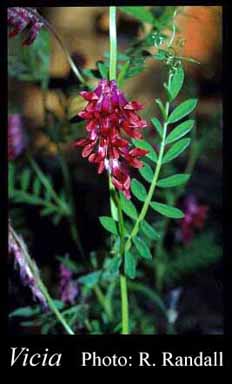- Reference
- Sp.Pl. [Linnaeus] 2:734 (1753)
- Name Status
- Current

Scientific Description
Family Papilionaceae. Vicieae.
Habit and leaf form. Herbaceous climbers; not resinous. ‘Normal’ plants (stems not winged). Plants unarmed. Annual to perennial. Leaves cauline. Plants with neither basal nor terminal concentrations of leaves. Young stems terete or angled, not winged. Climbing; tendril climbers, or tendril climbers and scrambling. Tendrils branched (terminating the leaves). Mesophytic. Leaves small, or medium-sized; alternate; distichous; ‘herbaceous’; not imbricate; petiolate; non-sheathing; compound; epulvinate; pinnate; paripinnate. Leaflets 6–20. Lateral leaflets opposite. Leaflets not stipellate; pulvinate, or epulvinate; elliptic, or oblong, or triangular, or linear; flat, or folded (ptyxis conduplicate); without lateral lobes. Leaflet margins flat. Leaf blades dorsiventral. Leaves with stipules. Stipules intrapetiolar; adnate to the petiole, or free of the petiole; free of one another; leafy (sometimes half sagittate); persistent. Leaf blade margins entire. Leaves without a persistent basal meristem. Stem anatomy. Secondary thickening absent, or anomalous.
Reproductive type, pollination. Fertile flowers hermaphrodite. Unisexual flowers absent. Plants hermaphrodite. Entomophilous.
Inflorescence and flower features. Flowers solitary, or aggregated in ‘inflorescences’; when solitary, axillary; 1–12 per axil (in ours). Inflorescences axillary; pedunculate axillary racemes or clusters. Flowers pedicellate; bracteate. Bracts deciduous (small, caducous). Flowers ebracteolate; small to medium-sized; odourless; very irregular; zygomorphic. The floral asymmetry involving the perianth and involving the androecium. Flowers papilionaceous (imbricate-descending, with the posterior petal outside and forming the ‘standard’); 5 merous. Floral receptacle developing a gynophore to with neither androphore nor gynophore. Free hypanthium present, or absent. Hypogynous disk present, or absent. Perianth with distinct calyx and corolla; 10; 2 -whorled; isomerous. Calyx present; 5; 1 -whorled; gamosepalous; five lobed. Calyx lobes markedly shorter than the tube. Calyx hairy, or glabrous; imbricate, or valvate; exceeded by the corolla; regular, or unequal but not bilabiate, or bilabiate; persistent; non-accrescent; with the median member anterior. Corolla present; 5; 1 -whorled; appendiculate, or not appendiculate. Standard not appendaged. Corolla partially gamopetalous. 2 of the petals joined (the two ventral petals connivent to form the ‘keel’), or 4 of the petals joined (usually, with the wings adherent to the keel). The joined petals anterior (or anterior and lateral). The wings of the corolla adherent to the keel (usually), or free from the keel; not laterally spurred. Standard ‘normally’ developed; emarginate; not sericeous. Keel conspicuously exceeded by the wings (incurved); not long-acuminate/beaked (blunt); neither coiled nor spiralled; not bent and beaked. Corolla imbricate (descending); white, or red, or pink, or purple, or blue (in various combinations); deciduous. Petals clawed. Fertile stamens present. Androecial members definite in number. Androecium 10. Androecial sequence determinable, or not determinable. Androecial members free of the perianth; all equal to markedly unequal; coherent (the filaments basally connate into a markedly oblique truncate tube); 2 - adelphous (9+1, with the tenth, posterior stamen free). The staminal tube free from the keel petals. Androecial members 1 -whorled (although diplostemonous). Androecium exclusively of fertile stamens. Stamens 10; all more or less similar in shape; diplostemonous; both opposite and alternating with the corolla members. Filaments filiform (above the tube). Anthers separate from one another, or connivent; all alike; dorsifixed; versatile; dehiscing via longitudinal slits; introrse; tetrasporangiate. Gynoecium 1 carpelled. The pistil 1 celled. Carpels reduced in number relative to the perianth. Gynoecium monomerous; of one carpel; superior. Carpel stylate; apically stigmatic. Style (in-) bent. Style flattened (dorsally or laterally), or terete. Style bearded via an apical tuft, or hairy but not bearded (hairy all round). Stigmatic tissue terminal. Carpel 2–15 ovuled. Placentation marginal (along the ventral suture). Gynoecium median (the placenta posterior, on the ventral suture). Ovary subsessile to stipitate. Ovules pendulous to ascending; biseriate; arillate; anatropous, or campylotropous to amphitropous, or hemianatropous.
Fruit and seed features. Fruit 6–50 mm long; stipitate to sessile; non-fleshy; hairy, or not hairy; not spinose. The fruiting carpel dehiscent; a legume. Pods much elongated (linear to oblong); not triangular; straight; not becoming inflated; more or less flat to somewhat compressed; irregularly constricted, or not constricted between the seeds; not transversely septate; wingless. Valves of the dehisced pod twisted. Fruit 1 celled. Dispersal unit the seed. Fruit in ours, 1–12 seeded. Seeds globular to ovoid; non-endospermic; not mucous; compressed; small; arillate. Cotyledons 2; accumbent. Embryo chlorophyllous; curved, or bent. Testa non-operculate; conspicuously colour-patterned. Micropyle zigzag, or not zigzag. Seedling. Germination cryptocotylar.
Physiology, biochemistry. Nitrogen-fixing root nodules present. Aluminium accumulation not found. Photosynthetic pathway: C3.
Geography, cytology, number of species. Native of Australia and adventive. 2n=14 (10, 12). A genus of about 140 species; 5 species in Western Australia.